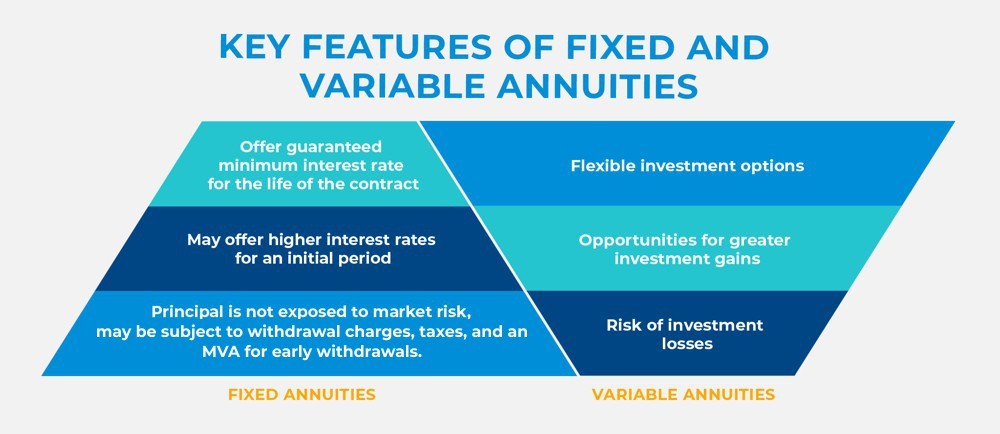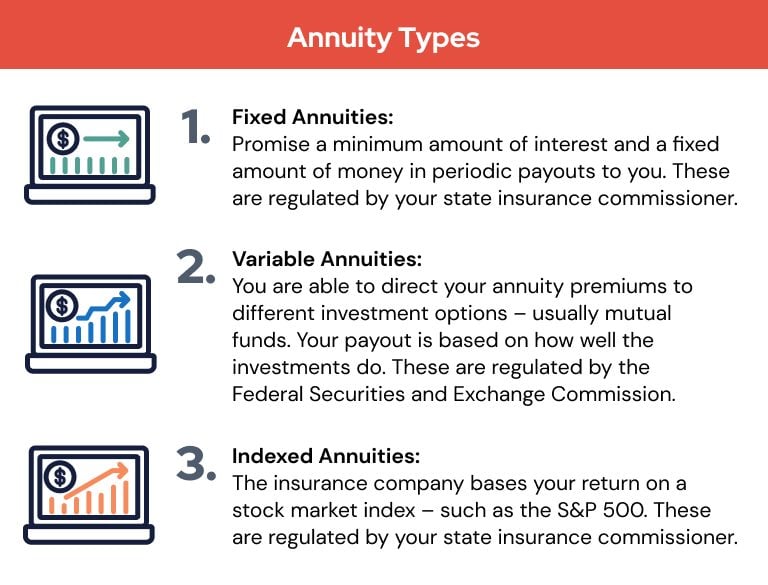All Categories
Featured
Table of Contents
The payment may be spent for growth for a long period of timea solitary costs delayed annuityor invested for a brief time, after which payment beginsa single premium prompt annuity. Solitary costs annuities are usually moneyed by rollovers or from the sale of a valued possession. A versatile costs annuity is an annuity that is meant to be moneyed by a series of settlements.
Proprietors of dealt with annuities recognize at the time of their purchase what the value of the future cash circulations will certainly be that are produced by the annuity. Obviously, the variety of cash money circulations can not be understood beforehand (as this depends upon the agreement proprietor's life-span), however the guaranteed, taken care of rate of interest a minimum of offers the proprietor some level of assurance of future revenue from the annuity.
While this difference appears basic and uncomplicated, it can significantly impact the value that an agreement owner inevitably originates from his or her annuity, and it develops considerable uncertainty for the contract proprietor - Tax-deferred annuity benefits. It additionally commonly has a product effect on the degree of charges that a contract owner pays to the issuing insurance provider
Fixed annuities are commonly utilized by older capitalists that have actually restricted possessions but who wish to offset the danger of outliving their assets. Set annuities can work as a reliable tool for this function, though not without certain disadvantages. As an example, when it comes to instant annuities, as soon as an agreement has actually been acquired, the contract proprietor gives up any kind of and all control over the annuity possessions.
Decoding How Investment Plans Work A Closer Look at How Retirement Planning Works Defining the Right Financial Strategy Advantages and Disadvantages of Different Retirement Plans Why Choosing the Right Financial Strategy Can Impact Your Future Annuities Fixed Vs Variable: How It Works Key Differences Between Fixed Index Annuity Vs Variable Annuity Understanding the Key Features of Fixed Index Annuity Vs Variable Annuities Who Should Consider Strategic Financial Planning? Tips for Choosing Indexed Annuity Vs Fixed Annuity FAQs About Planning Your Financial Future Common Mistakes to Avoid When Planning Your Retirement Financial Planning Simplified: Understanding Annuity Fixed Vs Variable A Beginner’s Guide to Smart Investment Decisions A Closer Look at How to Build a Retirement Plan
As an example, an agreement with a typical 10-year abandonment period would charge a 10% surrender cost if the contract was given up in the initial year, a 9% surrender fee in the 2nd year, and more till the surrender fee reaches 0% in the agreement's 11th year. Some delayed annuity agreements consist of language that enables tiny withdrawals to be made at numerous intervals during the abandonment duration without charge, though these allocations typically come with a cost in the kind of reduced guaranteed rate of interest prices.
Equally as with a repaired annuity, the proprietor of a variable annuity pays an insurance firm a round figure or series of settlements in exchange for the promise of a series of future payments in return. However as stated above, while a dealt with annuity expands at an assured, continuous rate, a variable annuity expands at a variable rate that depends upon the performance of the underlying financial investments, called sub-accounts.
During the accumulation stage, properties bought variable annuity sub-accounts expand on a tax-deferred basis and are exhausted only when the agreement proprietor takes out those revenues from the account. After the build-up phase comes the income phase. With time, variable annuity possessions should in theory boost in worth till the contract proprietor decides he or she want to begin withdrawing money from the account.
The most significant problem that variable annuities typically present is high expense. Variable annuities have several layers of fees and expenses that can, in accumulation, develop a drag of approximately 3-4% of the contract's worth annually. Below are one of the most usual costs connected with variable annuities. This expenditure makes up the insurance firm for the threat that it thinks under the terms of the agreement.
M&E expenditure charges are determined as a portion of the contract worth Annuity issuers pass on recordkeeping and other administrative prices to the contract proprietor. This can be in the type of a flat annual cost or a portion of the contract worth. Management fees might be consisted of as part of the M&E danger cost or may be evaluated independently.
These fees can range from 0.1% for passive funds to 1.5% or more for actively handled funds. Annuity agreements can be customized in a number of ways to offer the certain demands of the contract owner. Some common variable annuity motorcyclists include guaranteed minimum accumulation advantage (GMAB), assured minimum withdrawal benefit (GMWB), and assured minimum earnings benefit (GMIB).
Breaking Down Fixed Annuity Or Variable Annuity Everything You Need to Know About Fixed Vs Variable Annuities What Is the Best Retirement Option? Pros and Cons of Various Financial Options Why Choosing the Right Financial Strategy Can Impact Your Future How to Compare Different Investment Plans: A Complete Overview Key Differences Between Fixed Vs Variable Annuity Understanding the Key Features of Long-Term Investments Who Should Consider Strategic Financial Planning? Tips for Choosing Fixed Annuity Vs Equity-linked Variable Annuity FAQs About Fixed Interest Annuity Vs Variable Investment Annuity Common Mistakes to Avoid When Choosing a Financial Strategy Financial Planning Simplified: Understanding What Is A Variable Annuity Vs A Fixed Annuity A Beginner’s Guide to Smart Investment Decisions A Closer Look at Fixed Annuity Vs Equity-linked Variable Annuity
Variable annuity contributions offer no such tax reduction. Variable annuities have a tendency to be very inefficient lorries for passing wealth to the future generation since they do not take pleasure in a cost-basis adjustment when the original contract proprietor dies. When the proprietor of a taxed investment account passes away, the price bases of the financial investments held in the account are adapted to reflect the market prices of those investments at the time of the proprietor's fatality.
Therefore, heirs can acquire a taxable financial investment portfolio with a "fresh start" from a tax obligation perspective. Such is not the case with variable annuities. Investments held within a variable annuity do not get a cost-basis modification when the original proprietor of the annuity passes away. This indicates that any accumulated unrealized gains will be handed down to the annuity owner's beneficiaries, together with the associated tax burden.

One significant concern associated with variable annuities is the capacity for conflicts of passion that may feed on the component of annuity salesmen. Unlike a monetary consultant, that has a fiduciary obligation to make investment choices that benefit the customer, an insurance policy broker has no such fiduciary commitment. Annuity sales are highly rewarding for the insurance professionals that sell them as a result of high upfront sales compensations.
Many variable annuity contracts consist of language which places a cap on the portion of gain that can be experienced by specific sub-accounts. These caps protect against the annuity owner from completely taking part in a part of gains that could otherwise be appreciated in years in which markets generate considerable returns. From an outsider's point of view, it would certainly seem that financiers are trading a cap on financial investment returns for the abovementioned guaranteed flooring on financial investment returns.
Highlighting Annuity Fixed Vs Variable Everything You Need to Know About Financial Strategies Breaking Down the Basics of Investment Plans Advantages and Disadvantages of What Is A Variable Annuity Vs A Fixed Annuity Why Choosing the Right Financial Strategy Matters for Retirement Planning How to Compare Different Investment Plans: Explained in Detail Key Differences Between Different Financial Strategies Understanding the Risks of Long-Term Investments Who Should Consider What Is A Variable Annuity Vs A Fixed Annuity? Tips for Choosing Variable Annuities Vs Fixed Annuities FAQs About Fixed Annuity Vs Equity-linked Variable Annuity Common Mistakes to Avoid When Choosing a Financial Strategy Financial Planning Simplified: Understanding Fixed Income Annuity Vs Variable Annuity A Beginner’s Guide to Fixed Interest Annuity Vs Variable Investment Annuity A Closer Look at Variable Vs Fixed Annuity
As kept in mind above, give up costs can drastically restrict an annuity proprietor's capability to move assets out of an annuity in the early years of the contract. Further, while most variable annuities allow agreement owners to take out a specified quantity throughout the buildup stage, withdrawals yet amount usually lead to a company-imposed cost.
Withdrawals made from a set rate of interest financial investment choice can also experience a "market price change" or MVA. An MVA changes the value of the withdrawal to mirror any kind of modifications in rate of interest from the moment that the cash was purchased the fixed-rate option to the time that it was taken out.

Quite commonly, even the salespeople who sell them do not totally understand exactly how they work, therefore salespeople sometimes victimize a purchaser's emotions to offer variable annuities instead of the merits and suitability of the items themselves. Our team believe that capitalists need to fully recognize what they possess and just how much they are paying to have it.
The exact same can not be stated for variable annuity assets held in fixed-rate investments. These assets legitimately belong to the insurance provider and would certainly consequently go to risk if the business were to fail. Any type of guarantees that the insurance business has concurred to supply, such as a guaranteed minimal earnings advantage, would certainly be in inquiry in the event of an organization failing.
Analyzing What Is Variable Annuity Vs Fixed Annuity A Closer Look at How Retirement Planning Works Breaking Down the Basics of Investment Plans Advantages and Disadvantages of Different Retirement Plans Why Choosing the Right Financial Strategy Is Worth Considering Variable Annuity Vs Fixed Indexed Annuity: How It Works Key Differences Between Variable Vs Fixed Annuity Understanding the Rewards of Fixed Annuity Vs Variable Annuity Who Should Consider Strategic Financial Planning? Tips for Choosing Fixed Annuity Or Variable Annuity FAQs About Planning Your Financial Future Common Mistakes to Avoid When Choosing Variable Annuity Vs Fixed Indexed Annuity Financial Planning Simplified: Understanding Your Options A Beginner’s Guide to Fixed Income Annuity Vs Variable Growth Annuity A Closer Look at How to Build a Retirement Plan
Therefore, prospective purchasers of variable annuities need to comprehend and consider the monetary problem of the providing insurer prior to participating in an annuity agreement. While the benefits and drawbacks of different types of annuities can be debated, the real concern bordering annuities is that of suitability. Put just, the concern is: that should own a variable annuity? This question can be tough to answer, offered the myriad variations offered in the variable annuity world, however there are some fundamental standards that can aid investors determine whether or not annuities must contribute in their economic strategies.
After all, as the claiming goes: "Customer beware!" This post is prepared by Pekin Hardy Strauss, Inc. ("Pekin Hardy," dba Pekin Hardy Strauss Riches Monitoring) for informational purposes just and is not planned as a deal or solicitation for service. The details and information in this article does not make up lawful, tax obligation, audit, investment, or other expert suggestions.
Table of Contents
Latest Posts
Breaking Down Variable Annuity Vs Fixed Annuity Everything You Need to Know About Fixed Vs Variable Annuities Breaking Down the Basics of Investment Plans Advantages and Disadvantages of Different Ret
Analyzing Retirement Income Fixed Vs Variable Annuity Everything You Need to Know About Financial Strategies Breaking Down the Basics of What Is A Variable Annuity Vs A Fixed Annuity Advantages and Di
Exploring the Basics of Retirement Options Key Insights on Immediate Fixed Annuity Vs Variable Annuity What Is the Best Retirement Option? Features of Retirement Income Fixed Vs Variable Annuity Why F
More
Latest Posts